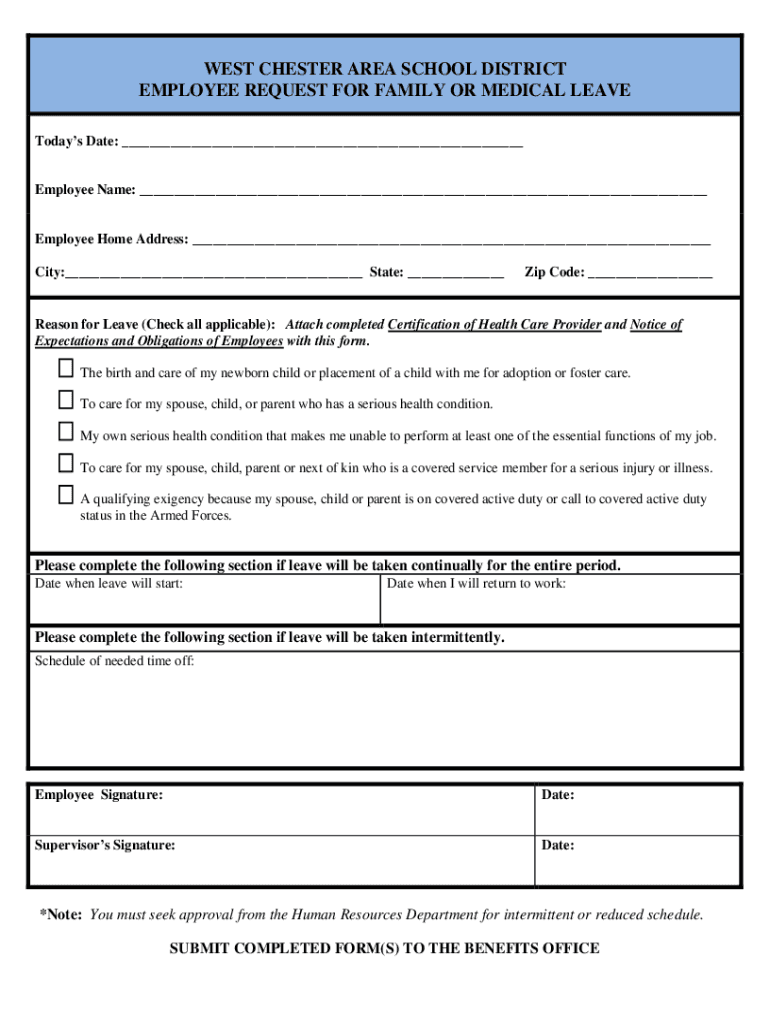Where to Get FMLA Paperwork Easily

Federal and state family and medical leave laws give you the right to take time off from work for certain qualifying reasons, such as the birth or adoption of a child, to care for a sick family member, or due to your own serious health condition. The key to taking leave under the Family and Medical Leave Act (FMLA) is having the right paperwork in order. Here's how to obtain, fill out, and submit your FMLA paperwork smoothly.
Understanding FMLA Eligibility

Before you dive into the paperwork, ensure you’re eligible for FMLA:
- You work for a covered employer - typically, organizations with 50 or more employees.
- You have worked for the employer for at least 12 months.
- You have worked at least 1,250 hours during the 12 months before the leave starts.
- You work at a location where your employer has at least 50 employees within 75 miles.
🔑 Note: Understanding your eligibility is crucial before proceeding with FMLA leave paperwork.
Where to Find FMLA Paperwork

Acquiring FMLA paperwork can be straightforward if you know where to look:
- Employer’s HR Department: The most direct route is to request forms from your Human Resources department. They’ll provide the company-specific forms or the generic Department of Labor (DOL) forms.
- U.S. Department of Labor Website: You can download the required forms, including the “Certification of Health Care Provider for Employee’s Serious Health Condition” (WH-380-E) and similar forms, from the DOL’s Wage and Hour Division website.
- Employee Assistance Program: Some companies offer EAP services, which might assist in navigating FMLA paperwork.
Filling Out FMLA Forms

Filling out FMLA forms is a detailed process to ensure your leave is legally recognized. Here’s what you need to do:
- Medical Certification: This requires the input from a healthcare provider who can certify your or your family member’s health condition. Forms like WH-380-E are used for this purpose.
- Employee Certification: Your section to fill out includes your personal details, the reason for leave, expected start and end dates, and other necessary information.
- Employer’s Section: While HR will usually handle this, be aware they’ll need information regarding your job duties, work schedule, and previous leave history.
Submission Process

Once you’ve completed your paperwork:
- Submit to Your Employer: Follow your employer’s procedure for submitting FMLA requests. This might be in person, via email, or through an HR portal.
- Track Your Request: Keep a record of submission dates and follow up if necessary. Responses should come within 5 business days by law.
- Maintain Documentation: Keep copies of all correspondence, forms, and medical certifications for your records.
📅 Note: Ensuring your employer promptly receives and processes your FMLA request is key to securing your leave rights.
How Long Does It Take to Process?

Timing is an essential element in processing FMLA paperwork:
- Medical Certification: Healthcare providers have up to 15 days to provide the certification. Remember, your leave can start before this certification is returned.
- Employer’s Decision: After receiving all the necessary documentation, your employer has 5 business days to approve or deny your request.
- Retrospective Approval: If you submitted your request but didn’t receive a decision, your leave might be protected retroactively if approved later.
Common Issues and How to Resolve Them

Sometimes, issues arise in the FMLA paperwork process. Here are common problems and their solutions:
- Delayed Responses: Follow up with HR. Escalate if necessary by discussing with a higher authority or your union representative.
- Errors in Forms: Correct any mistakes with your healthcare provider or your HR team promptly.
- Leave Denied: Understand the reason for denial and, if you believe it’s incorrect, seek legal advice or contact the DOL.
What If FMLA Isn’t An Option?

If you’re not eligible for FMLA or your state offers additional benefits:
- State Family Leave Programs: Some states have their own family and medical leave laws, which might provide protections beyond FMLA.
- Company Policies: Your employer might have policies providing leave in cases not covered by FMLA.
- Short-term Disability: If your condition qualifies, consider applying for short-term disability benefits.
To summarize the process, it's about knowing your rights, obtaining the proper forms, completing them with the necessary certification, and submitting them through your employer's HR system. Keep meticulous records and track your request to ensure compliance with legal guidelines. If issues arise, stay proactive by following up or seeking external support. Remember, even if FMLA isn't an option, other leave opportunities might be available to you.
Can FMLA be taken intermittently?

+
Yes, FMLA can be taken intermittently, which means you can take leave in separate blocks of time or by reducing your work hours as needed. This might be appropriate for treatments or ongoing conditions.
What if my employer does not have FMLA paperwork?

+
You can download the necessary forms from the U.S. Department of Labor website or use generic forms that meet the minimum legal requirements for certification.
Do I need to provide medical records for FMLA leave?

+
No, while your healthcare provider needs to certify your condition, the medical records themselves are typically not required. However, enough detail to confirm eligibility must be provided.
What if I’m denied FMLA leave?

+
If you believe the denial is incorrect or in bad faith, you can appeal to your employer, consult with your HR department, or seek legal counsel.
How do I keep my job protected while on FMLA?

+
By following the proper procedures, submitting your request on time, and ensuring all documentation is in order, your job is legally protected, and you’re entitled to return to the same or an equivalent position.



